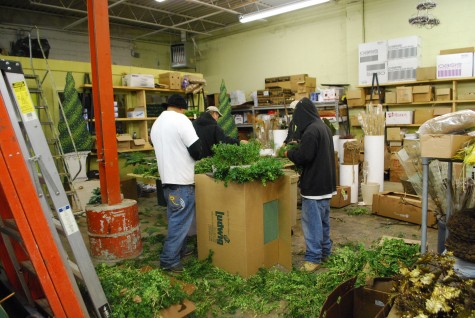 A good client whom I really like from Ypsilanti drove up this afternoon with his Mom. He was after materials for both of their winter pots. In the course of our conversation he told me he not only liked reading Dirt Simple, he was surprised and appreciative that I explain how I do things. No doubt how I do things is based on many years of experience with what does not work so well, interspersed now and then with a few good ideas. My thought process, my construction process-I have no reason not to share that. Should anyone decide to take on assembling their own winter pots based on my advice-this makes me feel like a useful human being. Most people share and teach at one time or another in their lives-their kids, their friends, their family-doing this means something. It means something to me too, and it feels great. Gardening is a messy, dirty, exhausting business; should you be game, I am more than happy to coach.
A good client whom I really like from Ypsilanti drove up this afternoon with his Mom. He was after materials for both of their winter pots. In the course of our conversation he told me he not only liked reading Dirt Simple, he was surprised and appreciative that I explain how I do things. No doubt how I do things is based on many years of experience with what does not work so well, interspersed now and then with a few good ideas. My thought process, my construction process-I have no reason not to share that. Should anyone decide to take on assembling their own winter pots based on my advice-this makes me feel like a useful human being. Most people share and teach at one time or another in their lives-their kids, their friends, their family-doing this means something. It means something to me too, and it feels great. Gardening is a messy, dirty, exhausting business; should you be game, I am more than happy to coach.
 I like selecting a palette of materials with a client. We have a discussion-a relationship. A little bit of me, and a lot of them makes for a good cocktail. Whatever I have inside that prompts me to suggest putting this with that-I am happy to share that. Having a shop full of possibilities makes the process fun.
I like selecting a palette of materials with a client. We have a discussion-a relationship. A little bit of me, and a lot of them makes for a good cocktail. Whatever I have inside that prompts me to suggest putting this with that-I am happy to share that. Having a shop full of possibilities makes the process fun.
 The reality of beautifully constructed winter containers can be daunting. To follow are the facts. I construct everything in my studio-garage; putting an arrangement together on site in freezing temperatures and late fall winds is tough to do promptly, and impossible to clean. The mess of the green discards is enormous. We have giant surfaces set up for the season to hold all the materials; the concrete floor obligingly holds no end of trash-it can be knee deep by the end of the day.
The reality of beautifully constructed winter containers can be daunting. To follow are the facts. I construct everything in my studio-garage; putting an arrangement together on site in freezing temperatures and late fall winds is tough to do promptly, and impossible to clean. The mess of the green discards is enormous. We have giant surfaces set up for the season to hold all the materials; the concrete floor obligingly holds no end of trash-it can be knee deep by the end of the day.
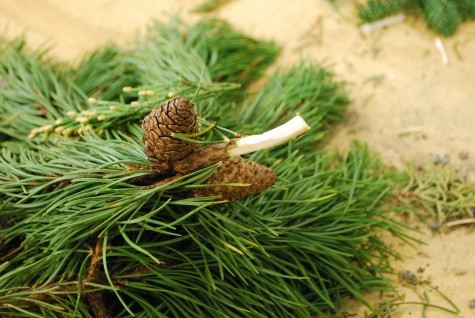 We whittle down every evergreen stem. This takes lots of time and effort. The big idea here? The above ground representation is vastly more showy than the below ground anchoring. How we anchor, and prepare a winter pot to last the six months until April requires what I would call work. For a tight fit, we sharpen the stems.
We whittle down every evergreen stem. This takes lots of time and effort. The big idea here? The above ground representation is vastly more showy than the below ground anchoring. How we anchor, and prepare a winter pot to last the six months until April requires what I would call work. For a tight fit, we sharpen the stems.
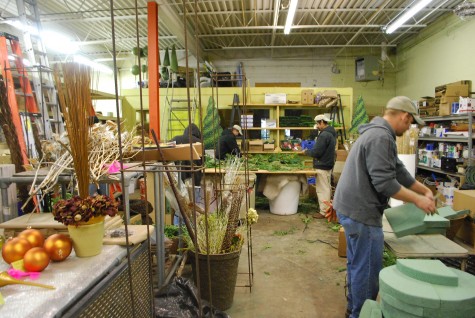 Everyone on my crews has a job. Forms, centerpiece construction, the stuffing of the greens-my two crews are 8 people. They produce work astonishingly fast. They spend a lot of time planting shrubs; this knowledge furnishes their construction with cut greens with a finished product that looks natural and believable.
Everyone on my crews has a job. Forms, centerpiece construction, the stuffing of the greens-my two crews are 8 people. They produce work astonishingly fast. They spend a lot of time planting shrubs; this knowledge furnishes their construction with cut greens with a finished product that looks natural and believable.
 This mixed evergreen winter blanket destined to warm a large round pot-It is beautiful, is it not? Should you have a mind to do it yourself, we observe these gweneral rules. We buy greens that are boughs, not the short pieces that are great for holiday floral arrangements. We aim for a low and wide overall shape-the greens are anywhere from 8-16 wider than the container all the way around. We green the edges of the form first, and work towards the center.
This mixed evergreen winter blanket destined to warm a large round pot-It is beautiful, is it not? Should you have a mind to do it yourself, we observe these gweneral rules. We buy greens that are boughs, not the short pieces that are great for holiday floral arrangements. We aim for a low and wide overall shape-the greens are anywhere from 8-16 wider than the container all the way around. We green the edges of the form first, and work towards the center.
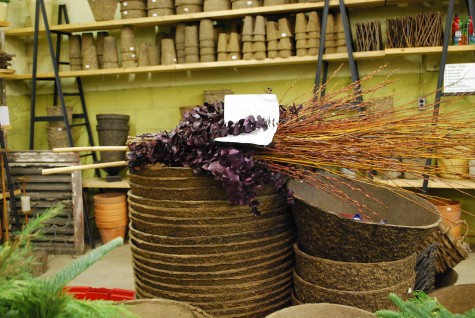 Materials chosen for a centerpiece-our process is to collect materials, and tag them with a name. The amounts needed for each element is based not only on the size, but the location of the container.
Materials chosen for a centerpiece-our process is to collect materials, and tag them with a name. The amounts needed for each element is based not only on the size, but the location of the container.
 The actual construction involves the numbers of bunches, the placement of picks, the overall shape. Relevant to the construction- great evergreen material, concrete wire, bamboo stakes, big zip ties, mini zip ties, foam forms. A conterpiece of this size has a stout bamboo stake which goes deep into the container. Additional anchoring with bamboo or steel is done during the installation.
The actual construction involves the numbers of bunches, the placement of picks, the overall shape. Relevant to the construction- great evergreen material, concrete wire, bamboo stakes, big zip ties, mini zip ties, foam forms. A conterpiece of this size has a stout bamboo stake which goes deep into the container. Additional anchoring with bamboo or steel is done during the installation.
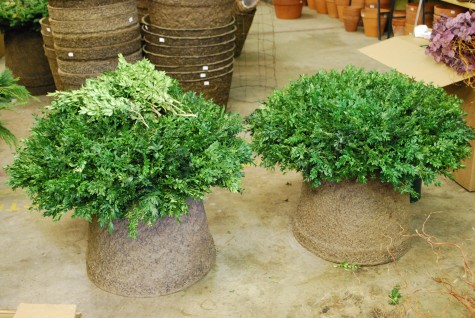
These boxwood sculptures have a lush look. Once they are dropped into their winter pots, there will be not hint of all the mess and hard work-just a graceful reminder of the garden that will be handsome to look at during the winter months.
 Were someone to ask me to name my most favorite winter pots ever, no doubt this pair would immediately come to mind. These varnished Belgian oak boxes put together with precisely spaced countersunk screws quietly remind me of a double breasted band uniform replete with brass buttons; dignified and all put together. The noble fir and douglas fir greens are generous and wide. The pale bleached willow sticks have a collar of natural stick stacks that have absorbed moisture from the air, and arched over-naturally. These pots have the most fabulously artless hairdos. Bottlebrush snowflakes hang here and there. Just enough structure meets weathering natural material. The good proportions of top to bottom please me.
Were someone to ask me to name my most favorite winter pots ever, no doubt this pair would immediately come to mind. These varnished Belgian oak boxes put together with precisely spaced countersunk screws quietly remind me of a double breasted band uniform replete with brass buttons; dignified and all put together. The noble fir and douglas fir greens are generous and wide. The pale bleached willow sticks have a collar of natural stick stacks that have absorbed moisture from the air, and arched over-naturally. These pots have the most fabulously artless hairdos. Bottlebrush snowflakes hang here and there. Just enough structure meets weathering natural material. The good proportions of top to bottom please me. 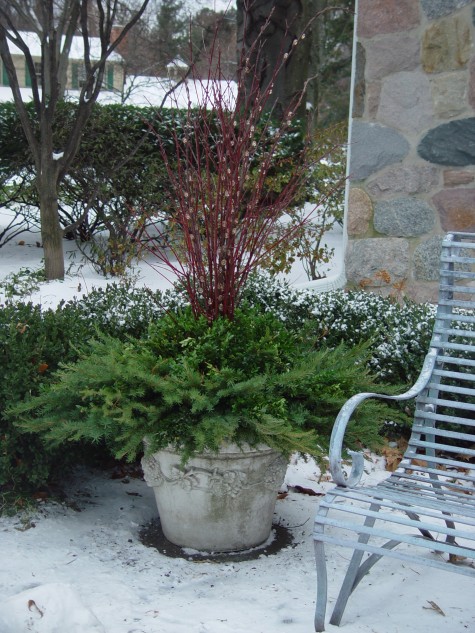 Though I personally have a mind to fend off the winter vigorously, I am lucky to have clients who do not mind the stillness of the winter season. They tell me: quiet, please. Represent me softly-naturally. Douglas fir and boxwood make such a great mix. A few stems of acrylic pussy willow adds just a little sparkle to the red twig.
Though I personally have a mind to fend off the winter vigorously, I am lucky to have clients who do not mind the stillness of the winter season. They tell me: quiet, please. Represent me softly-naturally. Douglas fir and boxwood make such a great mix. A few stems of acrylic pussy willow adds just a little sparkle to the red twig. 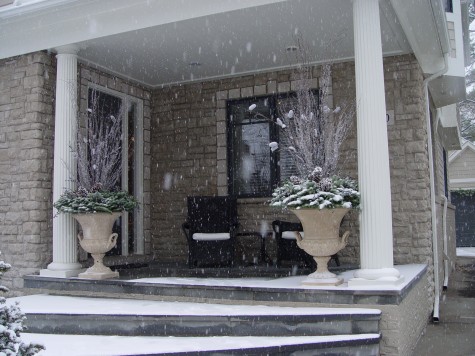 Intermittent snow in December dusts everything with white. This is beautiful winter weather-not the hit you over the head winter that is to come. The winter sculpture in this pair of pots demands nothing and expresses everything of a world gone silent.
Intermittent snow in December dusts everything with white. This is beautiful winter weather-not the hit you over the head winter that is to come. The winter sculpture in this pair of pots demands nothing and expresses everything of a world gone silent. 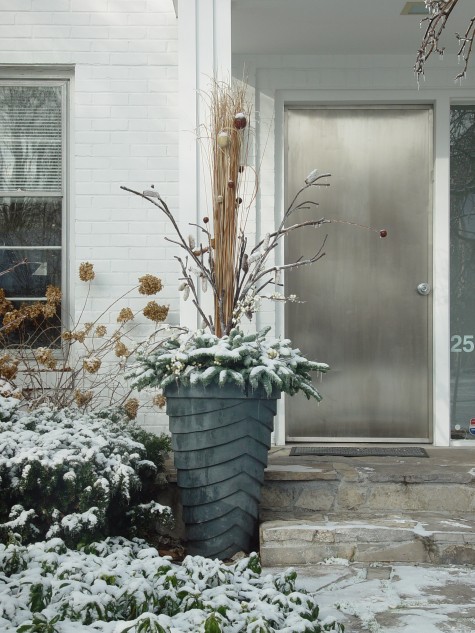 This client refurbished her front door in brushed stainless steel at my recommendation. This very contemporary Francesca del Re pot, and its winter dress, simply expresses the colors and shapes of her season. The color echoes what already exists in her hydrangeas and yews.
This client refurbished her front door in brushed stainless steel at my recommendation. This very contemporary Francesca del Re pot, and its winter dress, simply expresses the colors and shapes of her season. The color echoes what already exists in her hydrangeas and yews.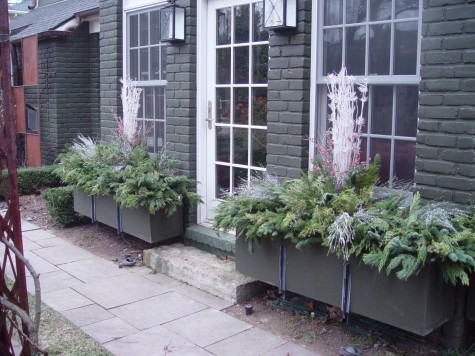
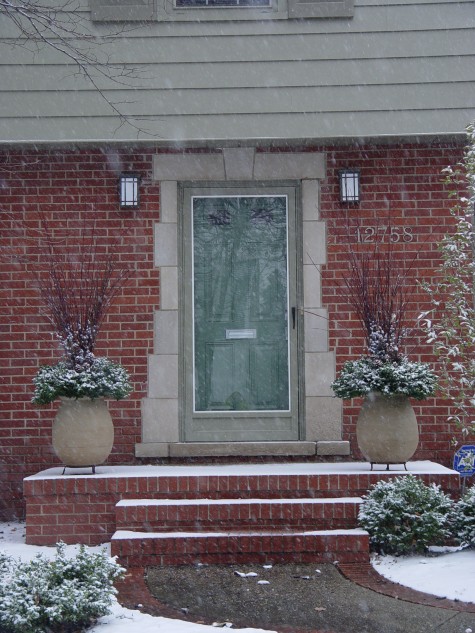 This pair of English stoneware pots from the Hode Pottery are frostproof-no need to bring them in. The simple trivet stands reveal the shape of the pots from top to bottom. A pot with a base larger than its opening benefits from a treatment like this. Twigs, cones and boxwood make for a dressy, not noisy display.
This pair of English stoneware pots from the Hode Pottery are frostproof-no need to bring them in. The simple trivet stands reveal the shape of the pots from top to bottom. A pot with a base larger than its opening benefits from a treatment like this. Twigs, cones and boxwood make for a dressy, not noisy display.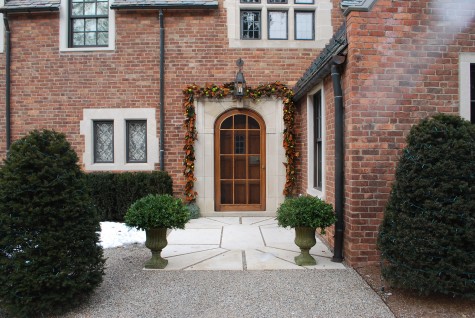

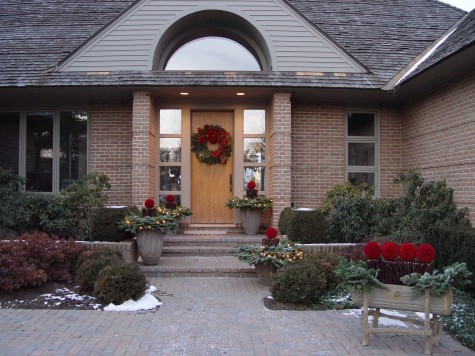
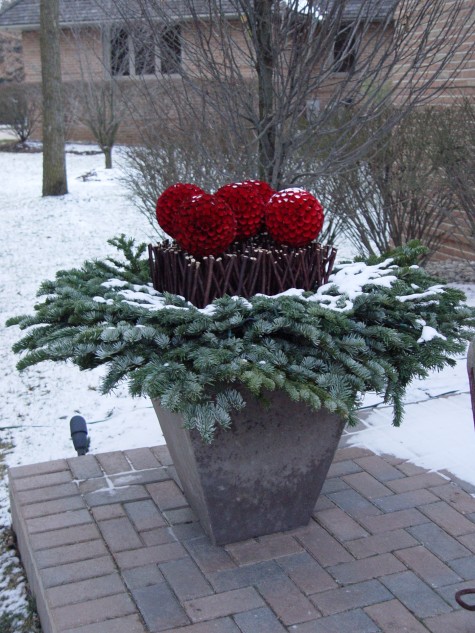
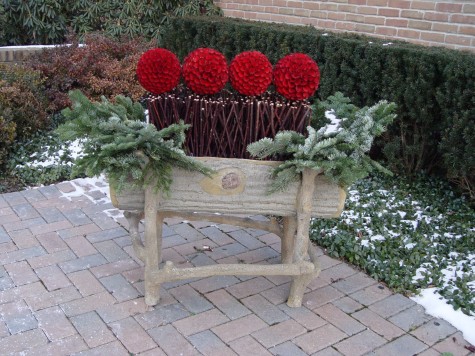
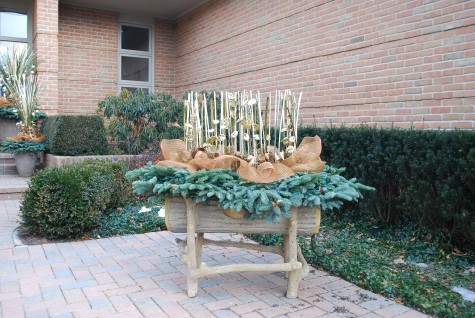
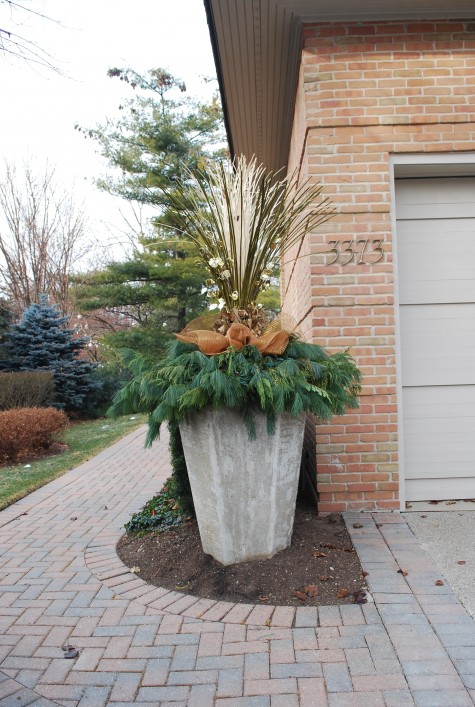 The walk to the front door is kept company by an overscaled concrete planter of our manufacture. The stick stack frames the house numbers on the wall. A walk that does not immediately appear to lead anywhere needs a strong signal-come this way, please. How the weather works on these twig stacks is a hand over which I have no control. They gracefully open and bend with the weather in a way I could not duplicate. Two parts a client, two parts nature, and one part from me-looking good.
The walk to the front door is kept company by an overscaled concrete planter of our manufacture. The stick stack frames the house numbers on the wall. A walk that does not immediately appear to lead anywhere needs a strong signal-come this way, please. How the weather works on these twig stacks is a hand over which I have no control. They gracefully open and bend with the weather in a way I could not duplicate. Two parts a client, two parts nature, and one part from me-looking good.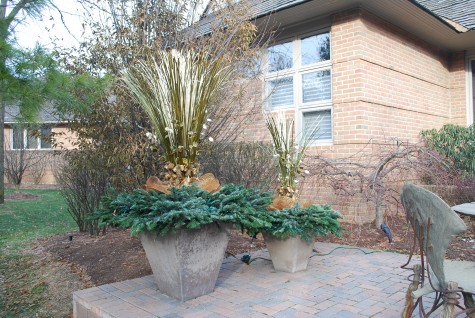 There is ample room on the terrace for this pair of Francesca squares. Like all of the other pots, these squares are sparingly lit. It is less than two weeks to the shortest day of our year.
There is ample room on the terrace for this pair of Francesca squares. Like all of the other pots, these squares are sparingly lit. It is less than two weeks to the shortest day of our year.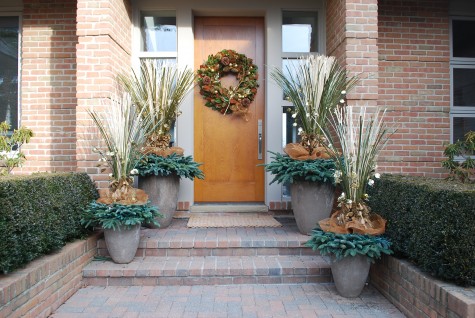 Four Francesca flutes make for a striking holiday garden at the front door. This Italian terra cotta is tough enough to withstand our vile winters; the ability to have terra cotta outside at this time of year is cause for celebration in and of itself. Some contemporary expression is hard on the eyes, and lacking human softening; this can border on cold. This is no time of year to add cold to the cold we already have. I so like how she chose materials so soft in color, and so subtle in contrast-it was up to me to put them together in a contemporary way. The interplay of contemporary and traditional elements is lively.
Four Francesca flutes make for a striking holiday garden at the front door. This Italian terra cotta is tough enough to withstand our vile winters; the ability to have terra cotta outside at this time of year is cause for celebration in and of itself. Some contemporary expression is hard on the eyes, and lacking human softening; this can border on cold. This is no time of year to add cold to the cold we already have. I so like how she chose materials so soft in color, and so subtle in contrast-it was up to me to put them together in a contemporary way. The interplay of contemporary and traditional elements is lively. 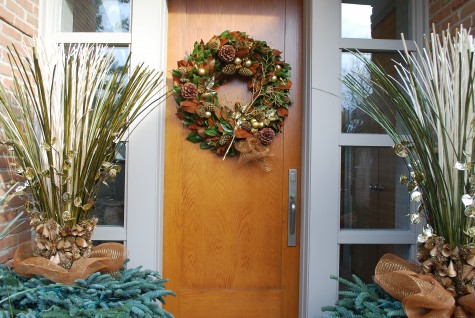
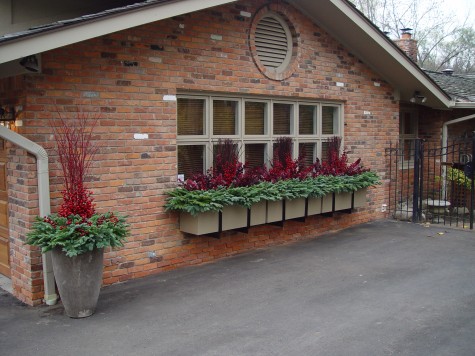 I do have a memory of getting into my Mom’s rouge pot in an idle moment. Those bright red perfectly circular spots of red I applied to my face made her laugh. I was terribly offended, as I thought I looked beautifully dolled up. All these years later I still like how a little rouge can doll things up; this is never more the case than in a garden gone wintry. Red twig dogwood and preserved and dyed eucalyptus can enliven a winter garden like nothing else does. I am not a fan of red tulips, or red dahlias; the red flowers and the green foliage is a little too much excitement for me. But the excitement generated by rouge red, in a garden gone grey, brown and black ,warms me up.
I do have a memory of getting into my Mom’s rouge pot in an idle moment. Those bright red perfectly circular spots of red I applied to my face made her laugh. I was terribly offended, as I thought I looked beautifully dolled up. All these years later I still like how a little rouge can doll things up; this is never more the case than in a garden gone wintry. Red twig dogwood and preserved and dyed eucalyptus can enliven a winter garden like nothing else does. I am not a fan of red tulips, or red dahlias; the red flowers and the green foliage is a little too much excitement for me. But the excitement generated by rouge red, in a garden gone grey, brown and black ,warms me up. 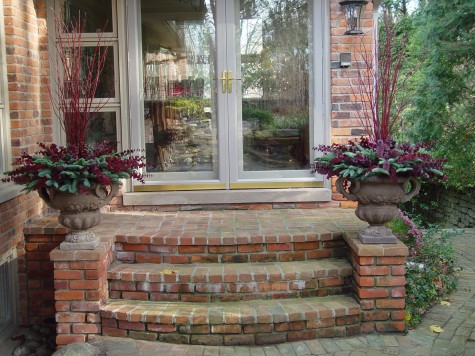 Dark red eucalyptus and red twig paired with the blue needled noble fir is a dramatic color combination. Very dark colors are best in small spaces viewed up close, or places backed up by a lighter color. The lighter orange/brown brick of this entrance makes that dark red read loud and clear. The big round leaves of the eucalyptus are a great foil to any needled evergreen branches.
Dark red eucalyptus and red twig paired with the blue needled noble fir is a dramatic color combination. Very dark colors are best in small spaces viewed up close, or places backed up by a lighter color. The lighter orange/brown brick of this entrance makes that dark red read loud and clear. The big round leaves of the eucalyptus are a great foil to any needled evergreen branches.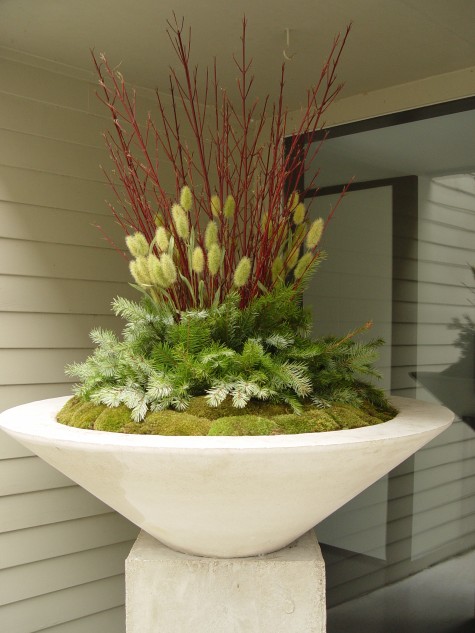 Bright red is all the more electric paired with a light green element. As no plant in the landscape has this form or color right now, I have no problem adding in artificial stems. Sometimes people ask how I could stand anything in a pot that wasn’t natural or real; it’s easy. Gardens make people feel good; if an artificial stem helps make an arrangement a little better and the winter a little more tolerable, I am all for it. This contemporary arrangement is all the more contemporary given the obviously faux detail.
Bright red is all the more electric paired with a light green element. As no plant in the landscape has this form or color right now, I have no problem adding in artificial stems. Sometimes people ask how I could stand anything in a pot that wasn’t natural or real; it’s easy. Gardens make people feel good; if an artificial stem helps make an arrangement a little better and the winter a little more tolerable, I am all for it. This contemporary arrangement is all the more contemporary given the obviously faux detail.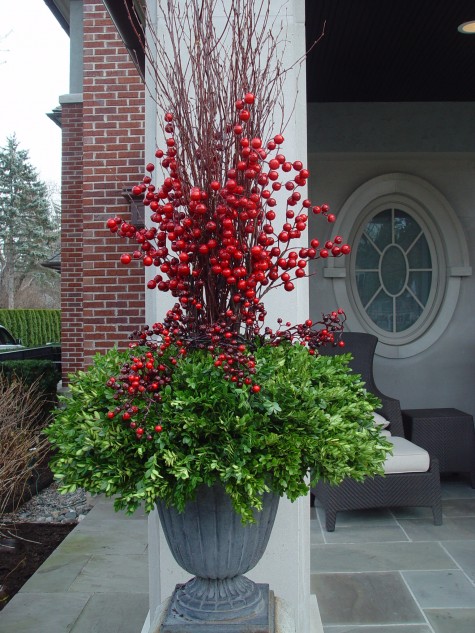 I am a fan of many shrubs and trees that sport berries in the fall and winter. However, they have a short lifespan, cut and in a container. The berries of Ilex Verticillata, or what we call Michigan holly, are spectacular but fragile. The berries in these urns will look great all winter, and can be removed the beginning of March. The boxwood might need a little floral dye sprayed on it by then, but I like keeping the pots intact until April sometime.
I am a fan of many shrubs and trees that sport berries in the fall and winter. However, they have a short lifespan, cut and in a container. The berries of Ilex Verticillata, or what we call Michigan holly, are spectacular but fragile. The berries in these urns will look great all winter, and can be removed the beginning of March. The boxwood might need a little floral dye sprayed on it by then, but I like keeping the pots intact until April sometime. 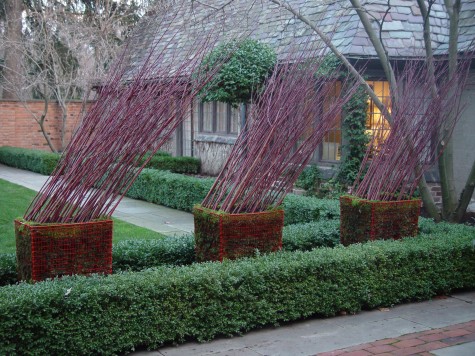 This wired and windswept winter display was entirely inspired by the floral arrangements of Jeff Leatham. His floral arrangements for the Four Seasons Hotel Paris, the George V often feature flowers set in vases at startling angles. This out of vertical placement attracts attention instantly. Each one of these dogwood stems were wired individually so the form would be kept intact whatever the weather.
This wired and windswept winter display was entirely inspired by the floral arrangements of Jeff Leatham. His floral arrangements for the Four Seasons Hotel Paris, the George V often feature flowers set in vases at startling angles. This out of vertical placement attracts attention instantly. Each one of these dogwood stems were wired individually so the form would be kept intact whatever the weather.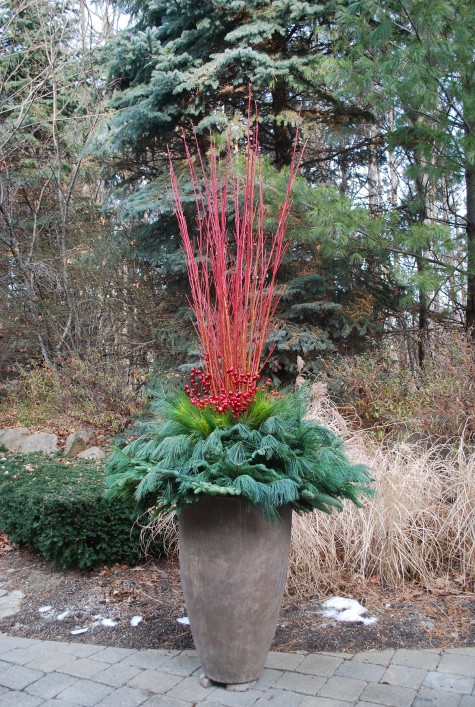 Cardinal redtwig is a relatively new cultivar that shines. It stands out so beautifully in front of the drab woodland background. We are sure to elevate the pot off the terrace surface, so water does not collect and freeze around the base.
Cardinal redtwig is a relatively new cultivar that shines. It stands out so beautifully in front of the drab woodland background. We are sure to elevate the pot off the terrace surface, so water does not collect and freeze around the base. 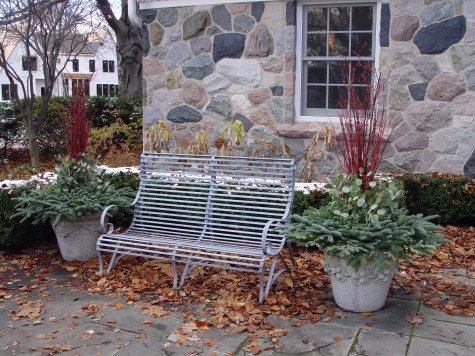 I have good success using fresh silver dollar eucalyptus outdoors. As it dries, the color does become more subtly taupe-blue, but the big leaves are an invaluable texture. The littleleaf euc tends to dry much faster and not to good end; I am not sure why. Eucalyptus pods dry blue, and hold their color well.
I have good success using fresh silver dollar eucalyptus outdoors. As it dries, the color does become more subtly taupe-blue, but the big leaves are an invaluable texture. The littleleaf euc tends to dry much faster and not to good end; I am not sure why. Eucalyptus pods dry blue, and hold their color well. 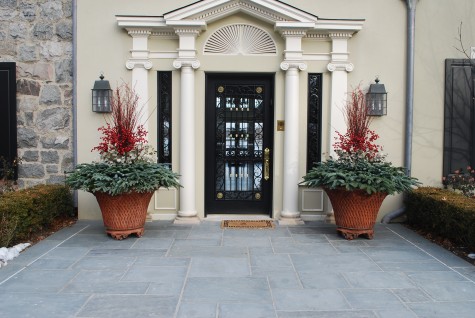 This pair of pots welcomes anyone who comes to visit. They make a very strong reference to my client’s love for their garden, from a long ways away.
This pair of pots welcomes anyone who comes to visit. They make a very strong reference to my client’s love for their garden, from a long ways away.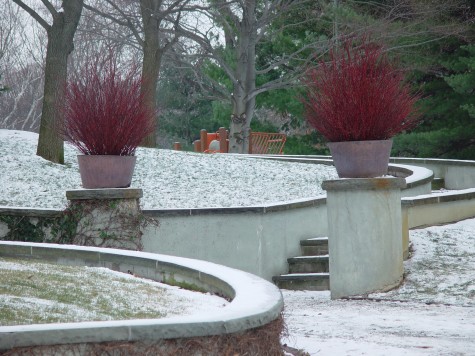 Likewise, this redtwig massed in copper pots, framing the view to a beautiful beech. Placed at least 75 feet from the road, they make a clear statement to passers by.
Likewise, this redtwig massed in copper pots, framing the view to a beautiful beech. Placed at least 75 feet from the road, they make a clear statement to passers by. 